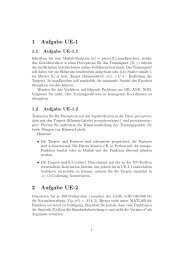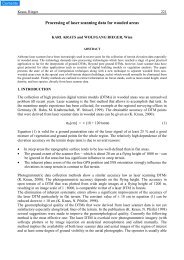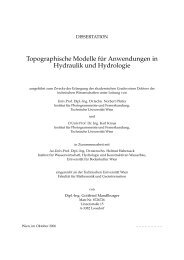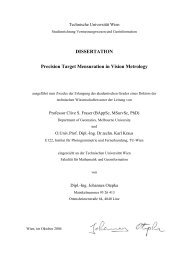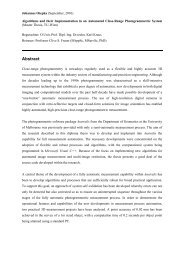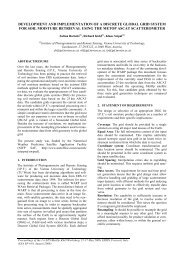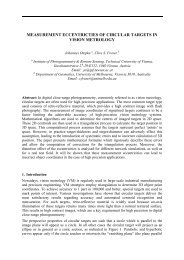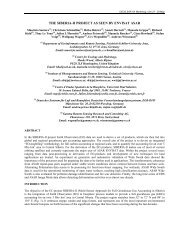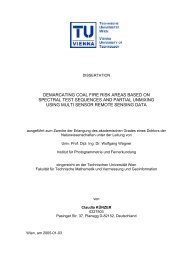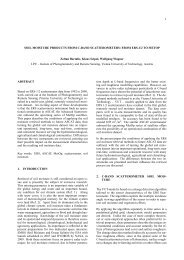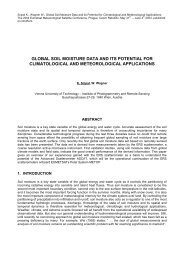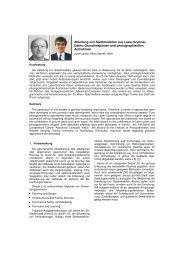Download - Institute of Photogrammetry and Remote Sensing
Download - Institute of Photogrammetry and Remote Sensing
Download - Institute of Photogrammetry and Remote Sensing
You also want an ePaper? Increase the reach of your titles
YUMPU automatically turns print PDFs into web optimized ePapers that Google loves.
Abstract<br />
High resolution multi- <strong>and</strong> hyperspectral remote sensing data form the basis <strong>of</strong> important spatially distributed<br />
biogeophysical products in support <strong>of</strong> crop management at a local to regional scale. Due to the<br />
infrequent <strong>and</strong> irregular data availability from single high resolution sensors, multi-sensor approaches are<br />
required to fill the gaps in data sequences <strong>and</strong> to guarantee data takes at critical time steps during the<br />
seasonal life-time <strong>of</strong> a crop. Prerequisite for such combined use is the consistency <strong>of</strong> single sensor products<br />
<strong>and</strong> the compatibility between the products <strong>of</strong> different origin. Developing robust algorithms for the<br />
retrieval <strong>of</strong> vegetation variables from remote sensing data is <strong>of</strong>ten hindered by the underdetermined nature<br />
<strong>of</strong> the problem, which is caused by the inferior number <strong>of</strong> independent earth observation dimensions<br />
compared to the large number <strong>of</strong> canopy elements causing variations in the radiometric signal. The main<br />
objective <strong>of</strong> this thesis is to address this issue in the context <strong>of</strong> developing an automated, image-based<br />
approach which is applicable to a wide variety <strong>of</strong> airborne <strong>and</strong> spaceborne high resolution sensors.<br />
The proposed approach, entitled CRASh, provides a concurrent retrieval <strong>of</strong> the key agricultural variables<br />
leaf area index (LAI), leaf chlorophyll content (Cab), leaf water content (Cw), <strong>and</strong> leaf dry matter<br />
content (Cdm), based on the combined inversion <strong>of</strong> the leaf optical model PROSPECT (Jacquemoud <strong>and</strong><br />
Baret, 1990; Fourty et al., 1996) <strong>and</strong> the 1-D turbid medium canopy structure model SAILh (Verhoef,<br />
1984; Verhoef, 1985). The inversion <strong>of</strong> these radiative transfer models allows for the exploitation <strong>of</strong> the<br />
entire information content contained in the data <strong>and</strong> facilitates optimizing for illumination/observation<br />
geometry <strong>and</strong> adapting to site specific phenology, background reflectance, <strong>and</strong> atmospheric conditions.<br />
In CRASh, model inversion is based on a lookup table (LUT) approach, which, apart from being computationally<br />
fast, <strong>of</strong>fers maximum flexibility to changing input parametrization.<br />
The presented approach entirely relies on the spectral image content <strong>and</strong> the information products<br />
provided by automated preprocessing <strong>of</strong> the data. Under this assumption, the lack <strong>of</strong> a priori knowledge<br />
on l<strong>and</strong> cover causes the inversion process to be strongly underdetermined <strong>and</strong> ill-posed, indicating that<br />
the system has multiple solutions. Two novel regularization techniques are proposed in this respect: the<br />
incorporation <strong>of</strong> an automated spectral l<strong>and</strong> cover classifier, <strong>and</strong> the assimilation <strong>of</strong> preliminary, a priori<br />
estimates <strong>of</strong> the output vegetation variables, calculated in place using predictive regression equations.<br />
Moreover, a new method, based on the local spatial neighborhood <strong>of</strong> the pixel under inversion, is suggested<br />
for dealing with systematic small scale attribution inconsistencies resulting from the l<strong>and</strong> cover<br />
classification.<br />
The suggested l<strong>and</strong> cover classification facilitates a more explicit characterization <strong>of</strong> spectral uncertainties<br />
<strong>and</strong> appeared very effective in reducing the uncertainties related to the individual inversion<br />
results, since the LUTs used for model inversion could be optimized for each l<strong>and</strong> cover type. Moreover,<br />
the LUTs that are calculated separately for every l<strong>and</strong> cover class <strong>and</strong> illumination/observation geometry<br />
allow for the generation <strong>of</strong> semi-empirical predictive equations optimized for each specific situation.<br />
These equations are based on the regression between spectral vegetation indices (VIs) calculated from<br />
the reflectance spectra contained in the LUT, <strong>and</strong> the variables used to simulate this canopy reflectance<br />
in the forward mode. The predictive equations obtained in this way are subsequently used to calculate a<br />
priori estimates <strong>of</strong> each variable <strong>and</strong> for every vegetation pixel in the image. The prior estimates, <strong>and</strong> the<br />
assessment <strong>of</strong> covariance between the several variables based on these estimates, play a decisive role in<br />
the stabilization <strong>of</strong> the model inversion <strong>and</strong> the reduction <strong>of</strong> ambiguous results between variables invoking<br />
complemental spectral behavior.



